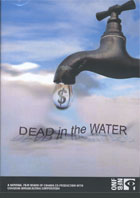
Dead in the Water 2006
Distributed by National Film Board of Canada, 1123 Broadway, Suite 307, New York, NY 10010; 800-542-2164
Produced by Neil Docherty, William Marsden, Adam Symansky
Directed by Neil Docherty
DVD, color, 52 min.
Sr. High - Adult
Environmental Studies, Water, Sociology, Economics, Developing Countries
Date Entered: 09/21/2007
Reviewed by Geetha Yapa, Science Library, University of California, Riverside“Do they make water?” This is a question asked by the poor people who simply cannot afford to pay for one of the bare necessities of life – water. Access to clean water is a basic human right. The amount of water available on earth now is the same as it was thousands of years ago during the time of dinosaurs. Increasing population has led to an increasing demand for water, creating opportunities for rich multinational companies to get richer by controlling the water, making it harder for the poor to have access.
This movie is about the tragic consequences of water privatization. It takes the viewer to four different countries to show different aspects of the water privatization process, and the effects on local communities and economies. The recent trend in privatization began with British Prime Minister Margaret Thatcher and U.S. President Ronald Reagan, supported by the World Bank, International Monetary Fund and the US Treasury. The film reveals how developing countries are pressured by the World Bank to move towards privatizing public services, thereby putting profits before people’s needs.
Their experimentations began in Argentina where the French companies who won the contract not only failed to deliver, but also broke promises and raised taxes. This led to widespread frustrations and street protests, and now the government is reexamining privatization. Meanwhile, people are still without water or sewage connections and 20% of child deaths in Argentina are considered to be water related. People in South Africa who never had to pay for water before, are now being forced to pay even before using the water. Here, experimentation with pre-paid water cards resulted in cholera due to contaminated water. The filmmakers document the protests and the insensitivity of the water company officials in dealing with local needs.
In California it is a different story where farmers were able to carry out a successful campaign to prevent big companies from trading their water on the Internet. In France, where water privatization originated, people have come to realize that water should be free. Not only does the film highlight corporate greed and corruption, it also reveals how individuals and poor countries are bullied and intimidated by corporate giants. This is a must see for those who are planning to privatize public services. It will make them think twice before giving in to pressure by big businesses and the World Bank.